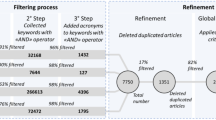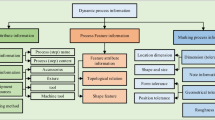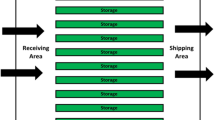Abstract
This paper presents a systematic approach for automatic assembly sequence plan generation (ASPG) by using an integrated framework of the part liaison matrix and precedence Boolean relations. The objective of this study is to propose a unified and integrated mathematical representation, manageable by computer programs, that allows an optimal assembly sequence be generated for various different production conditions and environment. To meet the aforementioned objective, a five-step modelling procedure is presented. In the first step, the product design and production information associated with part allocations and assembling sequences are logically arranged, simplified and systematically coded into the liaison matrix and precedence Boolean algebraic expression. In the second step, the position and assembly sequence relations of the original product are simplified into the so-called sub-assembly by using a group-like technology method. By doing so, the liaison matrix and precedence Boolean relation of the grouped sub-assemblies can then be easily obtained in the third modelling step. In the fourth modelling step, the constrained precedence Boolean relations of the grouped sub-assemblies are characterised and generalised for use in the proposed model. By simultaneously solving the aforementioned general and constrained position and precedence Boolean relations, the optimised assembly sequence of the underlying product can be quickly obtained in the fifth modelling step. A product assembly example is presented to illustrate the effectiveness of the proposed modelling approach. The enhancement of assembly efficiency and quality are also carefully evaluated .
Similar content being viewed by others
References
Bourjault A (1984) Contribution à une approach méthodologique de I’assemblage automatisé: Elaboration automatique des séquences opératoires, Thèse d’état, Université de Franche-Comté, Besancon, France
De Fazio TL, Whitney DE (1987) Simplified generation of all mechanical assembly sequences. IEEE J Robot Autom 3(6):640–658
Homem de Mello LS, Sanderson AC (1991) Representations of mechanical assembly sequences. IEEE Trans Robot Autom 7(2):211–227
Huang YF, Lee CSG (1989) Precedence knowledge in feature mating operation assembly planning. Proc. of 1989 IEEE Int’l Conf. on Robotics Automation, pp 216–221
Homen de Mello LS, Sanderson AC (1990) AND/OR graph representation of assembly plans. IEEE Trans Robot Autom 6(2):188–199
Thomas JP, Nissanke N, Baker KD (1996) Boundary models for assembly knowledge representation. IEEE Trans Robot Autom 12(2):302–312
Thomas JP, Nissanke N (1997) Assembly planning for boundary models of objects. Proc. of 1997 IEEE Int’l Conf. on Assembly Task Planning pp 146–151
Wolter JD (1989) On the automatic generation of assembly plans. Proc. of 1989 IEEE Int’l Conf. on Robotics Automation, pp 62–68
Warrts JJ, Bobeschanscher N, Bronsvoort WF (1992) A semi automatic assembly sequence planner. Proc. of 1992 IEEE Int’l Conf. on Robotics Automation, pp 2431–2437
Dini G, Santochi M (1992) Automated sequencing subassembly detection in assembly planning. Ann CIRP 41(1)1–4
Gottipolu RB, Ghosh K (1995) An integrated approach to the generation of assembly sequences. Int J Comput Appl Technol8:125–138
Sanderson AC, Homem de Mello LS, Zhang H (1990) Assembly sequence planning. AI Mag 11(1):62–81
Linn RJ, Tu HY (1993) Automatic precedence relationship extraction for assembly sequence generation. J Des Manuf 3:105–119
Huang YF, Lee CSG (1990) An automatic assembly planning system. Proc. of 1990 IEEE Int’l Conf. on Robotics Automation, pp 1594–1599
Rajan VN, Nof SY (1996) Minimal precedence constraints for integrated assembly execution planning. IEEE Trans Robot Autom 12(2):175–186
Hsu W, Lee CSG, Su SF (1992) Feedback evaluation of assembly plans. Proc. of 1992 IEEE Int’l Conf. on Robotics Automation, pp 2419–2424
Laperrière L, El Maraghy HA (1992) Planning of products assembly disassembly. Ann CIRP 41(1):5–9
Kanai S, Takahashi H, Makino H (1996) ASPEN: computer-aided assembly sequence planning evaluation system based on predetermined time standard. Ann CIRP 45(1):35–39
Laperrière L, El Maraghy HA (1994) Assembly sequences planning for simultaneous engineering applications. Int J Adv Manuf Technol 9:231–244
Marehalli JN, Sturges RH (1999) Practical passive assembly: gripper design assembly sequence optimization. Proceedings of the 1999 ASME Design for Engineering Technical Conferences, Las Vegas, pp 473–481
Güngör A, Gupta M (2001) Disassembly sequence plan generation using a branch-and-bound algorithm. Int J Prod Res 39(1):481–509
Lee S (1992) Backward assembly planning with assembly cost analysis. Proc. of 1992 IEEE Int’l Conf. on Robotics Automation, pp 2382–2391
Ben-Arieh D (1994) A methodology for analysis operations’ difficulty. Int J Prod Res 32(8):1879–1895
Dini G, Failli F, Lazzerini B, Marcelloni F (1999) Generation of optimized assembly sequences using genetic algorithms. Ann CIRP 48(1):17–20
Chen SF, Liao XY (1999) Stable assembly sequence planning using a genetic algorithm. Proceedings of the 1999 ASME Design for Engineering Technical Conferences, Las Vegas, pp 563–569, 12–15 September 1999
Author information
Authors and Affiliations
Corresponding author
Rights and permissions
About this article
Cite this article
Lai, HY., Huang, CT. A systematic approach for automatic assembly sequence plan generation. Int J Adv Manuf Technol 24, 752–763 (2004). https://doi.org/10.1007/s00170-003-1760-5
Received:
Accepted:
Published:
Issue Date:
DOI: https://doi.org/10.1007/s00170-003-1760-5




